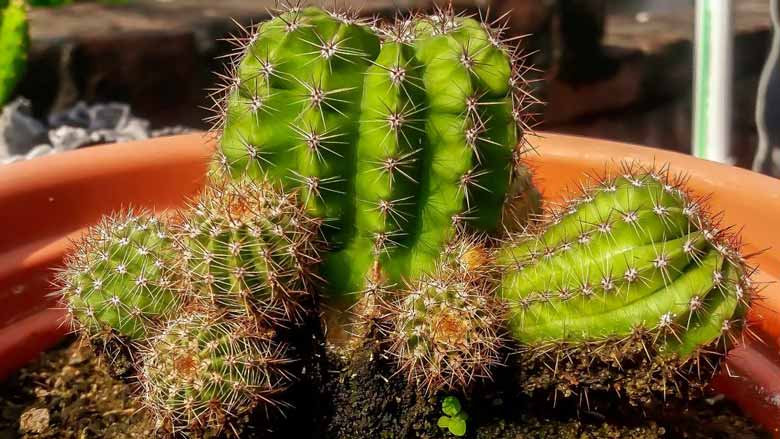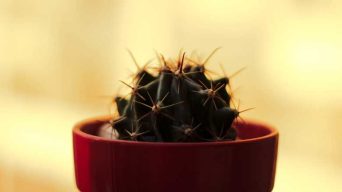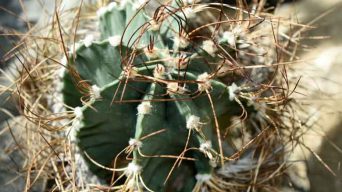Cactus root rotting, caused by the fungus Phytophthora cactorum, threatens these desert plants. Symptoms include stem discoloration, mushy roots, and wilting spikes. Prevention involves proper watering, well-draining soil, and regular repotting. Treatment includes removing affected roots, replacing soil, and using hydrogen peroxide or fungicides. Timely intervention is crucial for cactus health.
Is the cactus your top choice for gardening? Do you appreciate their aesthetic appeal and the simplicity of their care?
If so, we regret to inform you of a potential issue.
Cacti can face a serious threat in the form of root rot, leading to their demise or stunted growth. Understanding the concept of root rot and effective strategies for rescuing cacti suffering from this condition is crucial before it’s too late.
This article will delve into the specifics of cacti root rot, provide insights into its treatment, and outline preventive measures to ensure that root rot doesn’t become a recurring problem.
Understanding Root Rot
Root rot is a fungal infection that adversely affects plants, particularly cacti and other desert varieties. The progression of this condition initiates with the infection of the plant’s roots, ultimately infiltrating the entire root system and taking control of the plant.
The primary culprit behind root rot is the fungus Phytophthora cactorum, which systematically dismantles cacti from within. The mechanism of infection involves the growth of a mycelium that penetrates plant tissue, giving rise to minuscule spores.
These spores, in turn, disseminate to other plants through water or insects acting as carriers. In the unfortunate event, these carriers traverse into another cactus garden, they unwittingly spread the disease.
Regrettably, cacti are particularly susceptible to root diseases due to the limited defense mechanisms in their root structure. Their roots lack robust protective measures, making them prone to infections. As cacti draw water from the soil, pathogens exploit this avenue to travel up into their stems, leading to various illnesses or, in severe cases, death.
Identifying Root Rot in Cactus Plants
Understanding the appearance of root rot in cactus plants is crucial for early detection.
Unchecked, this rot can proliferate and lead to the demise of your cactus.
Key symptoms of root rot often include:
Cactus Stem Discoloration
Cacti will show clear signs of cactus stem discoloration when root rot is left untreated.
Cacti with root rot may lose their bright green color and turn yellow or brownish.
Disintegrating Plant Tissue
Cacti that are affected by root rot often have disintegrating plant tissue because the roots become infected. This causes them to die off and expose the cactus core to air.
Once exposed, it can quickly dry out, and dead tissue will fall away from the living part of your plant, leaving a hollow space within its central cavity.
Mushy Cactus Roots
Cacti with root rot will often have mushy cactus roots.
This is because as the plant core becomes infected, it swells and starts to fill up the central cavity of your plant, where its stem connects to its roots.
Eventually, this swelling can cause a rupture, allowing soil particles, water, and bacteria into your cacti center, causing further damage.
Soft or Discolored Spots on Stems
If you notice soft or discolored spots on any part of your plant stem, then there may be a high chance that they are suffering from root rot.
In many cases, these spots will also appear waxy, but if left untreated, rot can quickly spread to the cacti spines and cause them to lose their vibrant color.
Weak Plant
Cacti suffering from root rot often lose their strength and become weak, which can cause them to fall over or collapse.
They will also become difficult to hold up and fall over even when cacti are watered properly.
Black Rot on Soil Surface
If you notice black spots of dead soil near the base of your cactus plant, this is a sign that its roots have been infected by root rot and may be dying off. This causes them to release their hold on the soil around them, causing it to decompose.
As they decompose, fungi such as molds begin to grow where the dead matter has settled at the base of your cactus or cacti.
Yellowing Spines
Root rot can cause cacti to lose their vibrant color because it will often affect the cacti’ spines.
As the cactus becomes infected, these yellowing spots may also appear on its spines along its stem or any other part of your cacti plant.
Wilting Spikes and Buds
Wilting spikes and buds often signal the presence of root rot, a prevalent symptom. If not addressed promptly, this affliction can permeate the entire plant internally, exacerbating the harm.
It’s crucial to note that once the rot infiltrates the internal components of a cactus, attempting to remedy external symptoms won’t salvage the affected areas.
Even immediate intervention may prove ineffective before visible discoloration of the stem occurs.
Internal Decay in Plant
Due to changes within a cacti’s vascular system, this infection causes internal decay and increased respiratory activity resulting from cellular degradation.
At this stage of the disease, any attempts at treatment will be useless even if they are administered immediately after detection unless all affected roots have been removed before further damage has occurred.
As mentioned, once the central cavity has been exposed, cacti with root rot will soon begin showing cactus stem discoloration.
Causes of Root Rot in Cactus Plants
Root rot on plants is a severe problem. It’s challenging to treat; if left untreated, the cactus plant can eventually die.
The most common causes of root rot in cacti are:
Overwatering
Excessive watering is the primary factor leading to root rot in succulents.
Cacti and succulent plants generally prefer to be grown in very well-draining soil that remains dry most of the time.
They usually don’t like having wet feet, so if you’ve recently given your cactus a big drink with lots of water, it may have developed rot.
Excessive watering can lead to root rot in a cactus in just a matter of days.
Poor Drainage Conditions
Planting cacti in poor drainage conditions is the second most common cause of root rot.
If you’re growing cacti outdoors, make sure they are planted on hills or mounds to improve their drainage conditions.
A raised bed will also improve your cacti’s drainage condition if you don’t have space outdoors to create a hill or mound for them.
Over-Fertilization
While some fertilizers can be useful when it comes to helping your cacti grow faster and healthier, overfertilizing these plants can quickly lead to cactus rot.
This happens because all excess fertilizer gets left in the cactus soil and causes the cacti to become overwatered.
Unsuitable Soil Mixture
When planting cacti or succulents, you must use a very well-draining cactus potting mix.
A commercial cactus potting mix is ideal because it contains pumice, lava rock, perlite, or sand which will help improve drainage conditions while holding onto just enough moisture so your plants don’t dry out too quickly.
If you’re not using a commercially available cactus potting mix, you can create your own mix by combining equal parts of all-purpose sand, perlite, and peat moss.
Using Pots With No Drainage Holes
Another common cause of root rot is planting cacti and succulents directly into decorative pots that don’t have drainage holes.
If you’re using a hanging basket to grow your cacti, ensure the container has proper drainage holes or drill some yourself if it doesn’t already come equipped.
If you can see water accumulating on top of your cacti’s potting mix when drenching it every two weeks, as outlined earlier, there isn’t enough air getting to those roots, which could lead to infection and cactus rot.
Prevention of Root Rot in Cactus Plants
Proactive prevention is essential to maintain the health of your cactus and avoid the development of root rot. Effective cacti care is the cornerstone of this approach.
To safeguard your cacti from root rot, follow these key steps:
1. Proper Watering
Cacti are desert plants, and they don’t need a lot of water. Water cacti only once the soil is dry to the touch.
Ensure the cactus is watered in the morning so the plant roots have enough time to dry out before nightfall.
2. Regular Repotting
If you want your cactus to remain healthy and not develop root rot, repot them every few years.
But make sure to use fresh soil when transplanting a cactus because the soil can carry cacti diseases, and old soil might have diseases that can be transmitted to the plants.
3. Ensuring Adequate Sunlight
Cacti need sunlight to remain healthy and avoid root rot.
Ensure the cactus receives at least six hours of intense direct sunlight daily to photosynthesize properly.
If you want to keep cacti indoors, ensure they receive sunlight through a window and not an artificial one.
4. Using Well-Draining Soil
Cacti soil should be a well-draining one.
Rotting roots start when cacti become waterlogged and don’t have proper drainage for their roots.
Use sandy soil or add sand into your regular potting mix to drain excess moisture from the cactus root zone better.
5. Using Pots with Proper Drainage Holes
Ensure your pot has drainage holes in the bottom so excess moisture can drain.
If there are no drainage holes, you must drill some into it yourself or use a terracotta flowerpot saucer designed for this purpose.
Treating a Rotting Cactus
The earlier you spot and treat this condition, the better your chances of saving your plant for root rot treatment.
If you catch a rotting cactus early enough, there’s a good chance it will respond positively to treatment.
There are several ways to treat rotting roots. Below, we will examine some of the most popular and effective ones.
1. Remove Rotted Roots
Removing all the rotted roots is one of the most common and effective ways to treat rot.
You should remove all rotted and soft parts of the roots. Be careful not to damage healthy roots while performing this procedure.
2. Trim Affected Parts
If you notice that only certain areas are affected by root rot, you can cut off all the affected parts of your plant.
However, you should use sterilized tools to prevent spreading the infection further.
3. Replace Potting Soil
An easy way to treat root rot is by replacing old potting soil with new fresh soil.
You will need a good-quality potting mix for this procedure.
Do not add fertilizer or other additives while preparing this mixture, as it may lead to additional problems later.
4. Allow the Cactus to Dry Out
If your cactus plant suffers from root rot, leaving the soil dry for about a week is best.
This will help kill pathogens or fungus on its roots and slow its growth rate.
5. Watering With Hydrogen Peroxide
One of the most effective ways to treat rot is by adding hydrogen peroxide (H202) solution to water when watering your plants.
Hydrogen peroxide kills fungi and other germs, promoting healthy tissue formation around the roots. It can be used alone or along with another treatment method.
6. Application of Fungicides
Fungicides are available in both chemical and organic forms.
These products can effectively treat rot, but you should carefully follow the instructions before using them to ensure they won’t damage your plant or cause other problems.
7. Dip Roots In Baking Soda Solution
One of the least expected ways to treat root rot is by dipping your roots in a baking soda solution from one teaspoon of baking soda mixed with two gallons of water.
Apply this solution every week for about four weeks. Use fungicides along with this treatment method to increase your chances of success.
8. Introduction of Beneficial Bacteria
Various bacterial species are crucial in preventing and treating root rot.
One such species is Bacillus subtilis, which produces enzymes that break down pathogens into less harmful substances.
These beneficial bacteria establish colonies on the surface of the roots, releasing antibiotics to combat pathogenic fungi and other harmful germs.
Caring For Your Cactus After Treatment
Once you have successfully treated your cactus plant, monitor its progress for several days or weeks until you are sure there’s no chance of recurrence.
If everything goes well, keep gradually increasing humidity levels to help the soil retain moisture while reducing watering frequency over time.
Ensure to water thoroughly, but never leave your plant in a puddle.
Remember that preventing rot is easier than curing this condition.
Regularly check your plant’s roots for any sign of fungus or other ailments while carefully checking new plants before bringing them home.
Keep all infected areas clean and dry at all times, avoid overwatering your plants, use soil that drains well but still holds some water, and never use soil from outside as it may contain harmful contaminants or pathogens.
Final Thoughts
Root rot is a potential concern for both novices and seasoned cactus plant enthusiasts alike. Detecting the issue early is key to ensuring the well-being of your cacti.
Prompt action is crucial if your cacti are afflicted with rot. Addressing the problem promptly will significantly benefit the long-term health of your cacti.







